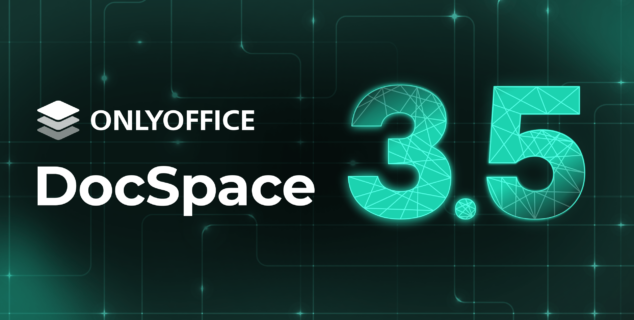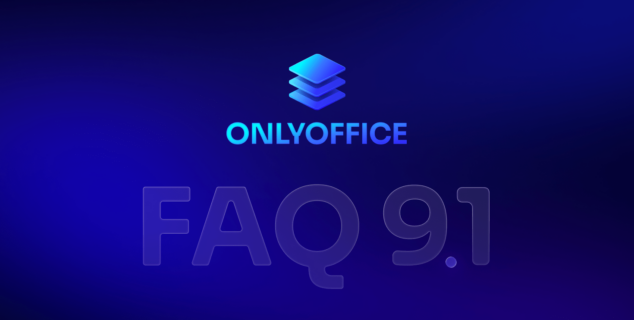7 powerful alternatives to Google Workspace (formerly G Suite)
Solutions like Google Workspace let you create a cloud-based office, facilitate collaboration, and boost productivity. But the latest price increase and concerns about data safety in cloud make people search for affordable and secure alternatives.
Want to replace Google Workspace in your company? Consider following solutions as your digital office.
ONLYOFFICE Workspace
ONLYOFFICE is an open-source collaborative office available in cloud and on-premises, as an enterprise-ready Workspace or as ONLYOFFICE Docs for personal or commercial use on any desktop or mobile device.
ONLYOFFICE document editors for text, sheets, and slides use DOCX, XLSX, and PPTX as core formats. It makes ONLYOFFICE a number one alternative to G Suite for teams seeking the highest compatibility with Microsoft formats. Files can be shared for editing, viewing, commenting, reviewing, form filling, and custom filtering. With third-party plugins you can translate texts in Google or DeepL, communicate in Telegram, create bibliographies in Mendeley or Zotero and much more.
ONLYOFFICE Workspace integrates the document editors with a collaboration platform. Managers can add projects, milestones, tasks and subtasks, assign them to employees, track time, visualize workflow with Gantt chart, and generate reports.
Workspace also includes document management system and enables the Private Rooms option that encrypts real-time collaboration on documents. The platform has CRM system, calendar, corporate mail and social network. It can be extended by connecting popular cloud storages Google Drive or Dropbox, professional services like Twilio, DocuSign, Amazon AWS S3 etc.
Workspace in the cloud is available for startups of up to 5 people free of charge, as well as community version for server installation for up to 20 users. Free versions of ONLYOFFICE Workspace include cloud-based plan for startups with up to 5 users and community version for server installation for up to 20 users. Compare plans>>
Pricing:
Startup — $0
Business — $5,00 per user/month
VIP — $8,00 per user/month
Comparative advantages:
- Project management tools
- Powerful document editors
- Integrations with popular third-party services
- CRM system included
- Custom email domain name
- Affordable
- Free plan
Summary:
ONLYOFFICE Workspace is a highly adaptive solution that can be deployed on-premises and keep sensitive corporate data inside. Private Rooms make collaboration in real time secure. Project management tools and the highest compatibility with MS formats makes ONLYOFFICE the best cheap alternative to G Suite for teams of any size.
Project management is available for free within an open-source platform ONLYOFFICE Groups. Free desktop editors allow working with documents on any operating system.
Try free ONLYOFFICE Workspace in the cloud to decide, whether it suits your team:
30 free days of the Business plan are included — later you can choose to stay or switch to the free Startup plan.
Asana
Asana is project management software with important tools to track tasks across teams: Kanban-style boards, Gantt charts, forms, calendars etc. The solution helps businesses streamline processes and automate routine tasks.

Managers can create custom projects or use templates. Every project contains tasks, which can be grouped into sections by topic. Larger tasks often consist of multiple subtasks assigned to employees. Due dates indicate when people must have their job done. Recurring actions like assigning tasks can be automated with custom rules in Asana.
Progress tracking is possible with the Timeline view, which is basically Gantt Chart. The Board view displays projects using sticky notes and whiteboards. Managers can generate reports, monitor workload, organize strategy, and have some insights about teams.
Numerous integrations extend capabilities of Asana. Users can attach files from Dropbox and Google Drive, edit documents in Google Docs, manage clients in Salesforce, make video calls in MS Teams, integrate Gmail and third-party calendars. There are more than 100 integrations in total.
Asana has a free plan with unlimited tasks, projects, messages, activity log, and file storage (100 MB per file). Paid versions include important tools — timelines, forms, milestones, portfolios etc. Free trials are available for each plan. Compare plans>>
Pricing:
Basic — $0
Premium — $10,99 per user/month
Business — $24,99 per user/month
Comparative advantages:
- Rich functionality for project management
- Automation for routine tasks
- Integrations with popular third-party services
- Customizable dashboards
- Reporting and analytics
- Free plan
Summary:
Asana is a cloud-based solution with advanced project management tools and flexible pricing. Besides workflow tracking capabilities unavailable in Google Workspace, the solution lets you connect third-party services for file management, communication, invoicing, planning and more. These advantages make Asana a competitive and affordable alternative to G Suite.
Wrike
Wrike is a project management solution with a focus on Gantt charts. Users can build analytics to learn insights about team performance and see infographics to know project implementation status.
With projects, tasks, due dates and dashboards to visualize current workflow, Wrike is often considered the best alternative to Asana. Users get notified whenever you assign a task and can apply multiple status, for example In Progress or Completed. Automation Engine is available to create rules and reduce manual repetitive work.
In the Workload tab managers can see who is available for new tasks. Timeline is where you can check how your projects is being implemented. Wrike has built-in time tracking — this tool is available in Google and Asana via third-party extensions only.
Wrike enables more capabilities with integrations, such as MS Teams for video conferencing, Salesforce for managing clientele, Google Drive for working with documents, services for online document editing and analytics etc.
Free plan provides you with basic task management, 2 GB storage space, cloud storage integrations, and Board view. Advanced plans have more storage space and enable connecting professional services, such as MS Project, Salesforce, and Business Intelligence. Branding options and higher security are only unlocked in the Business and Enterprise plans. Compare plans>>
Pricing:
Free — $0
Professional — $9,80 per user/month
Business — $24,80 per user/month
Enterprise — on request
Comparative advantages:
- Rich functionality for project management
- Automation for routine tasks
- Integrations with popular third-party services
- Built-in time tracking
- Reporting and analytics
- Free plan
Summary:
Wrike is a cloud-based customizable project management solution that offers additional tools with integrations and lets you apply own logos. Automation helps handle routine tasks effectively and avoid human error. Wrike has important native task tracking tools and therefore considered one of the best Asana and G Suite alternatives.
The solution has the most powerful tools in the Business and Enterprise plans, which makes Wrike pretty expensive for smaller businesses.
Microsoft 365
Microsoft offers a comprehensive solution with widely known Word, Excel, and Powerpoint for document editing. Additional tools for businesses are forms, calendar, OneDrive cloud storage, video calls in Skype and Teams, automation tools and more.
Microsoft 365 is focused on businesses that use text documents, spreadsheets, and presentations everyday. The solution has a native widely-known office suite, which makes Microsoft one of the best Wrike alternatives. No need to buy an additional subscription for document editors.
Project management functionality is pretty limited when compared to Asana or Wrike. Microsoft To Do and is rather about planning, but you can also assign tasks to other people, set start and due dates, view time reports.
Any business plan enables up to 300 participants in video calls via MS Teams, email hosting with 50 GB mailbox and custom domain name, and 1 TB of file storage. Forms help get info from clients, OneNote is good for note taking, and email client Outlook facilitates email management.
Microsoft 365 does not have a free subscription, but you can try any plan free for 1 month. More expensive plans provide you with the office apps for desktop and advanced security, for example Azure Information Protection. If you only need office apps and storage on OneDrive, there is an option for you too. Compare plans>>
Pricing:
Basic — $5,00 per user/month
Standard — $12,50 per user/month
Premium — $20,00 per user/month
Office apps & OneDrive — $8,25 per user/month
Comparative advantages:
- Native document editing
- Spacious cloud storage
- Video conferencing
- Custom email domain name
- Deployable as hybrid cloud
- Basic project management capabilities
Summary:
Microsoft 365 is a complete digital office with apps for file management, document editing, and real-time communication. The solution can be integrated into your infrastructure as hybrid cloud to deploy most sensitive workloads on-premises. This capability makes Microsoft 365 a recommended G Suite alternative.
Some shortcomings are prices, which are similar to Google Workspace. Besides, you need to pay an annual commitment — it can be a large sum for smaller businesses. Despite of the mixed deployment model, there are still concerns about the way Microsoft handles personal data.
Monday.com
Monday.com is a highly customizable project management solution. Managers can adapt it to any team, create projects, plan events, and track progress. Automation for recurring tasks reduce manual repetitive work and human error.
Boards are where the project planning starts on Monday.com. They contain portfolios with projects and additional information for each of them. It can be budget, location, status, and assignee — actually every detail you feel can be important. Team members can communicate right in comments to each project.
Different views help visualize deadlines for each project in calendar and even show you map locations for events, if you set one. Board view shows progress as a chart, Timeline view is also included.
Among integrations you can equip your web office with are Twilio and Mailchimp for reaching out to customers, Gmail for communication, Zoom and MS Teams for video conferencing, Google Drive and Calendar for planning etc.
Teams of 1-2 users get Monday.com for free with unlimited boards, 200+ templates, 20+ column types, and mobile apps. Most features are however available in paid versions only. They are Gantt Chart, Timeline, automation, time tracking, additional file storage etc. Compare plans>>
Pricing:
Individual — $0
Basic — $8,00 per user/month
Standard — $10,00 per user/month
Pro — $16,00 per user/month
Enterprise — on request
Comparative advantages:
- Rich functionality for project management
- Automation for routine tasks
- Integrations with popular third-party services
- Build-in time tracking
- Free plan
Summary:
Monday.com is a cloud-based solution for project management with customizable boards. It can be tailored to the needs of virtually any team or industry. With free plan for 1-2 users, it is one of the best G Suite alternatives for freelancers who need basic time planning only.
While you may not notice any difference with Google‘s prices here, some important tools like document editors are available only with third-party services.
OpenProject
OpenProject is a powerful open-source project management and team collaboration tool. It allows defining objectives and tracking tasks using Gantt charts, creating product roadmaps, and generate reports. The solution is available for on-premise deployment.
In OpenProject teams can plan tasks, use the Timeline view to visualize workflow, create and share product roadmap with stakeholders, add Kanban boards. You can assign tasks, leave comments and replies, create custom reports for accurate, current insight into project performance and allocated resources.
OpenProject is really focused on security and offers on-premise deployment. No need to worry about how your personal data is handled by a software vendor. The solution is GDPR compliant, among additional security features are Single sign-on, 2FA, LDAP authentication.
Migrating to OpenProject is easy, if you worked in Jira, MS Project, GitHub, Trello or Slack. These services can be connected to OpenProject. However, you may need a separate office suite to work on text documents, spreadsheets, and presentations.
Free community version includes all features from the paid versions, except for some capabilities like custom theme, graphs on project overview page, full-text, advanced security and prioritized support. Compare plans>>
Pricing:
Community — $0
Enterprise cloud — from $5,50 per user/month (1 year)
Enterprise on-premises — from $6,75 per user/month (1 year)
Comparative advantages:
- Rich functionality for project management
- Automation for routine tasks
- Authentication security options
- On-premise deployment
- Open-source
- Free plan
Summary:
OpenProject is an open-source project management solution suitable for agile teams. Focused on a variety of tools for progress tracking, OpenProject is a free and open-source alternative to Asana or Wrike. Besides, it keeps corporate data within you business IT infrastructure.
Whereas Google provides you with a complete document editing suite, it seems to be missing in OpenProject. If you often work on documents, spreadsheets or presentations, it will be good to have Google at least for personal use.
Jira
Jira is a popular workplace environment where managers can plan projects, prioritize tasks, and track progress. The solution is suitable to create product roadmaps and share them with a team or stakeholders.
Jira is perfect for IT companies, though can be tailored to the needs of any team. You can add projects, indicate status, assign tasks, track issues, plan releases and more. The solution is known for high-level security with Single sign-on, password policies, encryption at rest and in transit.
Task implementation tracking is possible with the Board view, Kanban and Scrum boards. Jira supports product roadmaps, generating reports to assess team performance. Users can create and customize various elements, such as tables, forms, timelines, reports, fields.
Numerous integrations extend Jira functionality: Google Drive and Docs for document management, Slack and MS Teams for messaging and communication, connectors for Salesforce, Zapier etc. There are over 1,000 integrations for Jira in Atlassian Marketplace.
Free plan is available for teams with up to 10 users, includes Kanban and Scrum boards, backlog, agile reporting, customizable workflows, integrations, basic roadmaps, and automation for a single project. More expensive plans allow up to 10,000 users, unlock more admin controls, storage, and additional security. Compare plans>>
Pricing:
Free — $0
Standard — $7,00 per user/month
Premium — $14,00 per user/month
Comparative advantages:
- Rich functionality for project management
- Automation for routine tasks
- Integrations with popular third-party services
- Reporting and analytics
- Free plan
Summary:
Jira is a cloud-based customizable project management solution with all necessary tools for agile teams. Advanced security, task tracking, Kanban and Scrum boards make it a free alternative to G Suite for startups.
The solution can be connected to hundreds of third-party apps for document editing, file management, email conversations, video conferencing. Integrations let you create a digital office that will fully meet your requirements. The most comprehensive plan of Jira is just a bit more expensive than the Business Standard of Google Workspace.
Share with us in the comments, what functionality you personally expect from a comprehensive G Suite alternative.
Create your free ONLYOFFICE account
View, edit and collaborate on docs, sheets, slides, forms, and PDF files online.










